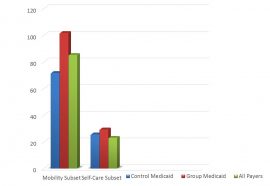As our payers become more complex, we as therapists need to discover ways to get better outcomes, in less time, with less reimbursement. Toward that end, we compared the functional outcomes, using the CARE item set, of our Medicaid skilled patients receiving more minutes of group therapy, as opposed to only individual minutes per our contract guidelines. We also compared the outcomes of our Medicaid patients who received group therapy to all of our patients who received all modes of therapy.
Methods
Group therapy was provided to Medicaid skilled patients following the below protocol for a two-month period:
- Patients with a POC for five times per week received three days of group therapy (average 45 minutes) and two days of individual therapy (average 15 minutes)
- Patients with a POC for three times per week received two days of group therapy (average of 45 minutes) and one day of individual (average of 15 minutes)
- All groups were functional-based and were individualized per each patient’s POC
- For all other payer types, all modes of therapy were used
Results
Results from the two-month study compared to two months prior (with no group therapy):
- Physical Therapy functional outcomes per the CARE items improved by 30 percent for the mobility subset
- Occupational therapy functional outcomes per the CARE items improved by 3.7 percent
- Culture in the department improved (per staff report)
- Patients asked to participate in group on days assigned as individual and had increased satisfaction in therapy (per resident reports/survey)
- Family members asked for their relative to be in groups more often (per family reports)
- Staff (CNAs) have extra time to attend to other responsibilities when multiple patients are away and patients were easier to care for with great improvement from better outcomes
- Productivity of the department improved by 5.8 percent
- Functional Outcomes comparing the Medicaid skilled patients receiving group therapy to all of the therapy patients: the mobility subset had 16.5 percent better outcomes, and the self-care subset had 6.3 percent better outcomes
Data

This chart shows the change in each CARE Item Set area between our control (two-month period) and our case study (two-month period), along with a comparison to the outcomes for all payers for the time period of our case study.
Conclusion
In conclusion, group therapy does improve functional outcomes versus individual therapy for Medicaid skilled patients. Additionally, outcomes were better for Medicaid patients who received group compared to all other patients (all payers) during the case study period.
In addition, group therapy provided other positive outcomes, including:
- Increased patient satisfaction
- Increased family satisfaction
- Increased staff satisfaction
- Improved culture in department
- Improved productivity
Group therapy has shown to be a valuable mode of therapy to increase outcomes, satisfaction and productivity. Use of this mode of therapy may benefit more payer types and may be a way to continue providing great therapy services by using our resources efficiently to help with our ever-changing world of healthcare.
By The Entire Rehab Team, Led by Tracy Carrier, DOR, Chandler Post Acute & Rehabilitation, Chandler, AZ
